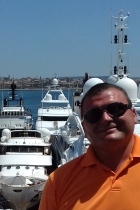
Like many industries, yachting has its share of unsung heroes doing all manner of skilled and important jobs that we never hear about. Following Matt Hyde's article about riding a yacht in transit, we wanted to know how these yachts are loaded onto carrier ships in the first place and discovered that 'float on/ float off' is not quite as simple as it sounds.
Speaking from Palma, former captain Andriy Antonenko is the Load Master with Florida-based DYT Yacht Transport, managing the loading and unloading of the company's two flo flo vessels, Super Servant 4 and the newer Yacht Express.
His job starts the moment a booking is made and doesn’t end until the yacht has been safely handed back into the hands of the owner or representatives. ‘This is a job which spans from start to the very end’, says Andriy. ‘I check all the documents received from the client, make preparations on board the ship and make a safe and proper plan with the operational department for the loading and offloading.’

Andriy’s role includes arranging divers to get the yachts into the right position for cradling as well as involving the crew of each yacht. ‘Around 70% of the manoeuvre is done by crew and 30% by the shore personnel’, he explains. ‘The divers are my eyes, they see the reality underwater and can tell if the boat needs adjustment. Each yacht and each operation is totally different.
‘For big operations, I have up to 10 divers in the water and one chief diver who communicates with me. The divers work in pairs for safety, there are always two or four divers working together and we position ourselves on the ship’s catwalk so that divers can easily find us and update us on status.’
Given the nature of the float on/ float off system, once Andriy starts loading yachts, he has to carry on until every last yacht is loaded, which could be anything from 15 to 60 yachts depending on their size.
It helps that Andriy has a seaman background and understands both sides of the equation. Born in the Ukraine, he undertook a marine education and started sailing in 1999 as an apprentice with a Dutch company. He progressed to Chief Officer and then to Captain, and started work on submersible ships in 2004, before moving ashore in 2013 to become a Load Master.

‘I was sailing ships for almost 15 years, so I have experience in this job from the seaman’s perspective too. I know both sides of the trade. I no longer travel with the vessels myself, but I fly into the ports to load and offload which is more convenient for my family.’
With yacht transportation being a very seasonal business, DYT’s busiest times are spring and autumn. ‘In summer time, people want to be in the Mediterranean and in the winter they want to be in the Caribbean,’ he explains. ‘And also many yachts attend the various shows throughout the world.’
The reasons for using yacht transportation are threefold, according to Andriy. ‘Some yachts just cannot cross the ocean on their own keel – due to size, fuel capacity or else. The yachts that can cross the ocean on their own keel might want to save on their engine running hours and/or avoid any wear and tear. ‘Crossing with us means not only saving on engine run time but also on crew time and materials.’

While Mediterranean transfers are popular, DYT also runs an annual Pacific Ocean trip, from Miami to Costa Rica, Tahiti, Australia and New Zealand which can take anything from two weeks up to two months to complete depending on the amount of stops. DYT transported over 1000 yachts last year alone.
And while crew are used to providing a five-star service to their owners and clients, the riders can experience some comforts themselves thanks to the hospitality on board Yacht Express. It boasts cabins, a conference room, media room, fitness centre and a large swimming pool.
During transit the crew can also carry out maintenance on their yachts so they arrive at their destination shiny and in tip-top condition.
After many years travelling the world, Andriy’s favourite spot is not so far away. ‘My favourite port is Palma de Mallorca,’ he admits. ‘I love it - the history, the people and the culture make the island very special.’
Related Articles:
What do You Know About Yacht Transport?
Riding a Yacht in Transit


Post your comment
You cannot post comments until you have logged in.
Login to post a commentComments
No one has commented on this page yet.
RSS feed for comments on this page | RSS feed for all comments